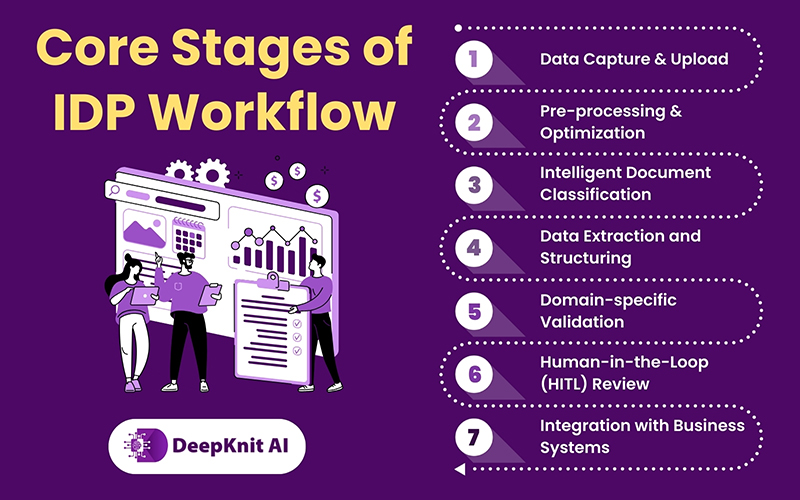Did you know that automated document workflows can reduce operational costs by a whopping 80%?
That’s right. By integrating Intelligent Document Processing (IDP) with generative AI and automation agents, organizations have reduced error rates and increased processing speed—delivering measurable gains in accuracy and employee satisfaction.
With the IDP market set to touch $10 billion in 2029 (from $3 billion in 2025), businesses are racing to digitize to meet the rising demand for speed, precision, and actionable insights across every industry. If that sounds like a game-changer to you, then you’re in the right place. Now let’s explore the step-by-step IDP workflow, powered by AI, and understand why DeepKnit AI (DK AI) is at the forefront, leading this charge.
What Is Intelligent Document Processing?
IDP is the modern evolution of document automation. Unlike legacy tools that merely “digitize” documents, this AI-powered technology analyzes, understands, and automates document-based workflows.
Think invoices, contracts, medical records, and forms. Instead of humans manually reviewing each file, IDP solutions like DeepKnit AI use advanced algorithms such as natural language processing (NLP), computer vision, machine learning, and intelligent OCR to accurately interpret and organize large volumes of structured and unstructured documents.
By automating these tasks, IDP enables organizations to achieve:
- Faster turnaround times
- Reduced errors
- Actionable analytics
- Seamless scalability
What Are the Core Stages of IDP Workflow?
- Data Capture & Upload
Goal: To collate documents from scanners, email attachments, file uploads, APIs, or mobile images.
- DeepKnit AI supports 50+ formats, and can connect to virtually any source, ensuring you never lose a critical document.
- This stage kicks off the AI-powered document automation journey and lays the groundwork for accurate analysis.
- Pre-processing & Optimization
Goal: Improve document quality and ensure readiness for analysis.
- Common techniques include binarization for clearer text, noise reduction, de-skewing, and brightness/contrast/saturation adjustments.
- DeepKnit AI automatically cleans and prepares files with advanced image optimization routines, maximizing OCR and extraction accuracy.
- Documents with smudges, staples, handwritten notes, or unusual layouts are handled robustly.
- Intelligent Document Classification
Goal: Categorize files by type (invoice, contract, medical record, etc.) and content.
- AI models — NLP, supervised and unsupervised ML, and Intelligent Character Recognition (ICR) — identify key features and context.
- Classification keeps workflows organized, routes documents to the right processes, and prevents mix-ups.
- DeepKnit AI’s context.l engine understands subtle document differences, whether you’re dealing with invoices or clinical notes.
- DK AI’s OCR/ICR delivers around 98% accuracy, enabling smooth downstream processing.
- Data Extraction and Structuring
Goal: Extract the required information—names, dates, totals, handwritten signatures, and more.
- Technologies: OCR (Optical Character Recognition), ICR (Intelligent Character Recognition), NLP, deep learning, and advanced CV (Computer Vision).
- DeepKnit AI excels at extracting both structured data (tables, forms) and unstructured data (emails, scanned PDFs).
- Custom extraction rules allow businesses to target exactly the information they need and structure it as tables or JSON.
- Domain-specific Validation
Goal: Ensure the extracted data is accurate and relevant for your business context.
- Algorithms apply rules, patterns, fuzzy logic, and regular expressions (Regex) to validate data.
- Especially valuable in industries like finance and healthcare, where data quality impacts compliance and outcomes.
- Advanced RPA integration ensures that the right checks happen without needing any manual intervention.
- DeepKnit AI adapts these validation routines to match your business’s unique requirements.
- Human-in-the-Loop (HITL) Review
Goal: Combine automation with targeted human oversight for maximum accuracy.
- Accuracy matters. When AI isn’t fully confident, or when regulations require diligent validation, DeepKnit AI flags items for human review.
- This seamless feedback loop trains the AI over time, thereby making the system smarter and more reliable with every cycle.
- Integration with Business Systems
Goal: Deliver processed information to downstream workflows viz. ERP, CRM, databases, analytics dashboards, RPA, or even as CSV/JSON exports.
- Automated data flow eliminates manual entry and re-keying, reduces delays, and speeds up reporting.
- DeepKnit AI’s plug-and-play integration means processed data lands exactly where you need it, ready for the next business action.
What Sets DeepKnit AI Apart in the Intelligent Document Processing Domain?
- Contextual AI: DeepKnit AI’s models don’t just automate; they understand the nuances/context.f your business environment.
- Customizable Precision: Fine-tune extraction and validation to match your internal workflows, and not generic, ‘one-size-fits-all’ solutions.
- Smart OCR & Document Analysis: Read, extract, and analyze data from any document type; even the hardest-to-read handwritten notes.
- Seamless Integration: Works with your ERP, CRM, and legacy applications, reducing disruption to existing business systems.
- Scalable & Flexible: Easily handle increasing document volumes and complexity, whether you’re processing thousands or millions of files per month.
- Tailored Solutions: Customizable automation models support advanced use cases, like medical records summarization, invoice reconciliation, and regulatory compliance.
Experience unmatched productivity, higher operational accuracy, and reduced costs with DeepKnit AI all while driving business innovation.
Benefits of Intelligent Document Processing for Businesses
- Enhanced Efficiency: Free up your staff from repetitive tasks and shorten processing cycles to under a minute.
- Faster Decision-making: Through real-time document analysis, you gain access to instant insights, helping in decision-making.
- Reduced Errors: Experience near-perfect accuracy with automated, AI-driven routines that eliminate typical human errors.
- Enhanced Compliance & Security: Robust validation prevents costly mistakes and also safeguards sensitive data.
- Scalability: Watch your document workflows grow without having to invest in manual effort or operational costs.
Industry Use Cases
- Healthcare: Automate EHR reviews, billing codes, clinical summaries, and claims documentation.
- Finance & Insurance: Speed up mortgage approvals, claims processing, KYC verification, and fraud detection.
- Retail & E-commerce: Organize order processing, shipment tracking, tax documentation, and inventory reconciliation.
- Logistics: Accelerate tasks like delivery confirmations, customs paperwork, and supply chain documents.
Final Thoughts
The future of document management isn’t years away—it’s already here! And it’s intelligent, automated, and context.ware. DeepKnit AI transforms everyday workflows into engines for growth, accuracy, and competitive advantage. With a robust and customizable approach, DK AI isn’t just another tool, but a trusted partner on your business process automation with IDP journey.
If you’re ready to drive productivity, reduce risk, and unlock new business value, it’s time to experience DeepKnit AI’s intelligent document processing solutions.
Paperwork Slowing Down Your Operations?
Elevate your automation game with DeepKnit AI’s smart IDP solutions
Contact Us


